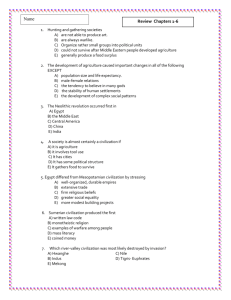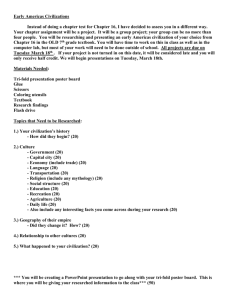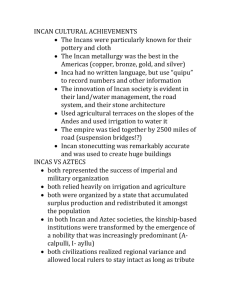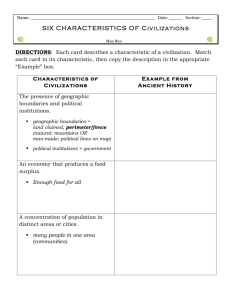The Earliest Americans(Teacher Edition).
advertisement
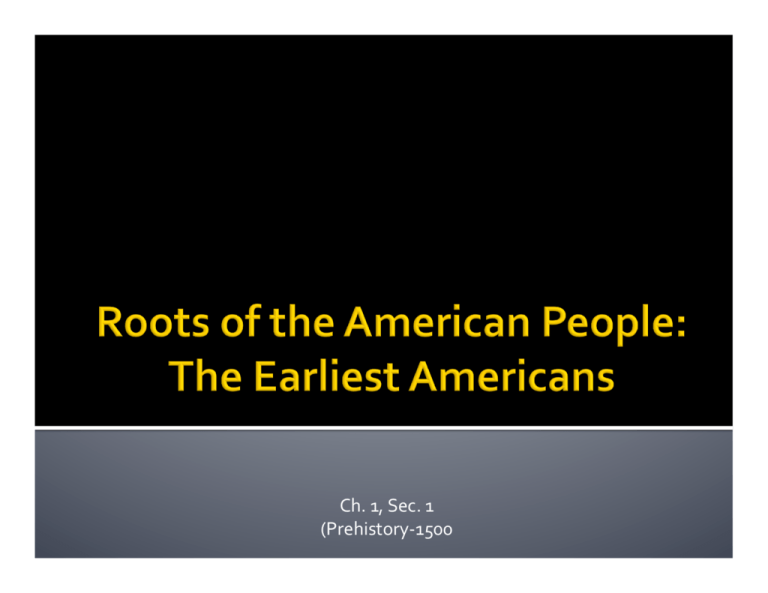
Ch. 1, Sec. 1 (Prehistory-­‐1500 ¡ 1. Students will understand how people may have first reached the Americas ¡ 2. Students will find out how people learned to farm ¡ 3. Students will explore the civilizations of the Mayas, Aztecs and Incas. ¡ The First Americans § The Land-­‐Bridge Theory § Other Theories § Learning to Farm ¡ Three Civilizations § Mayas § Aztecs § Incas ¡ Glacier – thick sheets of ice ¡ Irrigate – a method to water crops by channeling water from rivers or streams ¡ Surplus – extra ¡ Civilization – an advanced culture in which people have developed cities, science, and industries ¡ Between 10,000 and 100,000 years ago, much of the world was covered by glaciers ¡ As more water froze, the water level in the oceans dropped ¡ Areas where shallow water had been turned into dry land ¡ One of these such areas stretched between Siberia and Alaska ¡ A bridge of land, many miles wide appeared, now it lies under a narrow waterway called the Bering Strait ¡ The Land-­‐Bridge may have appeared and disappeared several times ¡ Scientists believe that the first people came to the Americans 20 to 30,000 years ago ¡ They also believe that they were probably hunters, searching for large mammals such as the wooly mammoth ¡ Hunting bands slowly spread across North and South America The Land-­‐Bridge Theory (Video) ¡ Not everyone accepts the Land-­‐Bridge theory as truth, some believe that people may have first crossed the arctic waters by boat and traveled southward along the Pacific Coast § Known as the coastal route theory ¡ Many Native Americans also dispute both theories, having their own creation stories which differ among each tribe ¡ For most of early civilizations, hunting was the primary means of survival. ¡ Game animals provided food, furs for clothing, and bones for tools ¡ In time, after much hunting, many larger animals began to disappear ¡ Deprived of their primary food source, hunters had to change their patterns ¡ In many place, hunters became gatherers, moving from place to place looking for small game & plants ¡ Around 8,000 years ago, gatherers in Mexico began growing food plants, including squash and lima beans. ¡ The discovery of farming transformed life and led to the development of modern civilizations ¡ No longer did families have to wander in search of food ¡ In dry regions, farmers began to develop systems of irrigation. ¡ They also learned how to raise animals such as cattle, pigs and llamas ¡ With a more dependable food supply, the population grew much more rapidly ¡ Native Americans began producing a surplus and trading with other groups ¡ No longer did families have to wander in search of food ¡ In dry regions, farmers began to develop systems of irrigation. ¡ They also learned how to raise animals such as cattle, pigs and llamas ¡ With a more dependable food supply, the population grew much more rapidly ¡ Native Americans began producing a surplus and trading with other groups How do scientists think people first reached the Americas? ________________________________________ ________________________________________ ________________________________________ ________________________________________ ________________________________________ ________________________________________ How do scientists think people first reached the Americas? Most scientists believe that the first people arrived by land. ¡ The development of farming led to the development of cities ¡ The development of cities led to the beginning of civilizations ¡ Over the centuries, several significant civilizations rose and declined in the Americas. ¡ The largest 3 were the Mayas, Aztecs, and the Incas ¡ The Mayas existed in what is now Mexico and Central America ¡ They built splendid cities containing large public plazas lined with pyramids, temples, ball courts, and palaces. ¡ They also developed arts, a system of government, and a written language. ¡ Their observation of the stars led to the most accurate calendar available, until modern times ¡ They carved the stories of their Gods and their histories into the stones of their buildings ¡ Around 900 A.D., they began to abandon their cities ¡ Why this happened remains a mystery. Most agree that it was either disease or over-­‐population ¡ The Mayan language is the root of over 20 civilizations in Central America today. As the Mayan civilization declined, another was on the rise ¡ The Aztecs built a great capital city, Tenochtitlan, on the site of present-­‐day Mexico City ¡ It was built on a series of small islands in the middle of a large lake ¡ The city was connected to the mainland by stone roadways ¡ Many farmers raised crops on floating platforms ¡ More than 200,000 people resided here during the height of the Aztecs, making it the largest city in the world at that time ¡ ¡ The center of the city was a sacred place with dozens of temples that honored Aztec gods ¡ Religion dominated Aztec life ¡ To the Aztec’s, prosperity depended on the good will of the Gods ¡ They, like a number of other civilizations, practiced human sacrifice as an offering to their Gods. ¡ During the 1400’s, Aztec armies brought half of modern-­‐day Mexico under their control ¡ They had effective, but harsh rulers ¡ Conquered tribes were forced to send treasure, food, and prisoners to the Aztec capital. ¡ They also forced these conquered people to pay extremely high taxes ¡ Resentful subjects would eventually turn on the Aztecs when they needed allies ¡ In the 1400’s, the largest empire was in South America ¡ The Incan Empire stretched down the coast of South America along the Andes mountains, across the Atacama desert, and reached the fringes of the Amazon rain forest ¡ At the center of the Incan empire was Cuzco, their capital ¡ It was linked to other cities by a great series and system of roads ¡ They constructed buildings of huge stones, carefully shaped to fit together. ¡ They built walls solid enough to contain soil, canals to carry water, and bridges over deep canyons. ¡ They produced fine weavings and metalwork ¡ They wore jewelry made from gold and silver Where were the Aztec and Inca civilizations located? _______________________________________ ________________________________________ ________________________________________ ________________________________________ ________________________________________ Where were the Aztec and Inca civilizations located? The Aztec civilization was in Central America and the Inca civilization was in South America. ¡ 1) Name one skill that people had to learn in order to grow crops ¡ 2) What benefits could farmers get from learning to raise animals? ¡ 3) What is a civilization? ¡ 4) How did the Mayas and Aztecs fit the definition of a civilization? 1. ________________________________________ ________________________________________ 2. ________________________________________ ________________________________________ 3. ________________________________________ ________________________________________ 4. ________________________________________ ________________________________________




